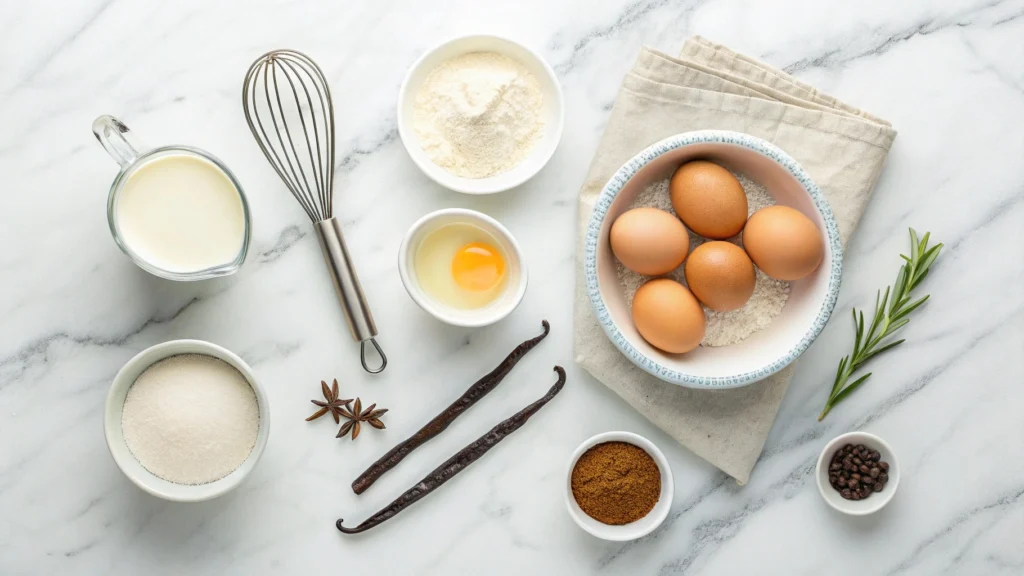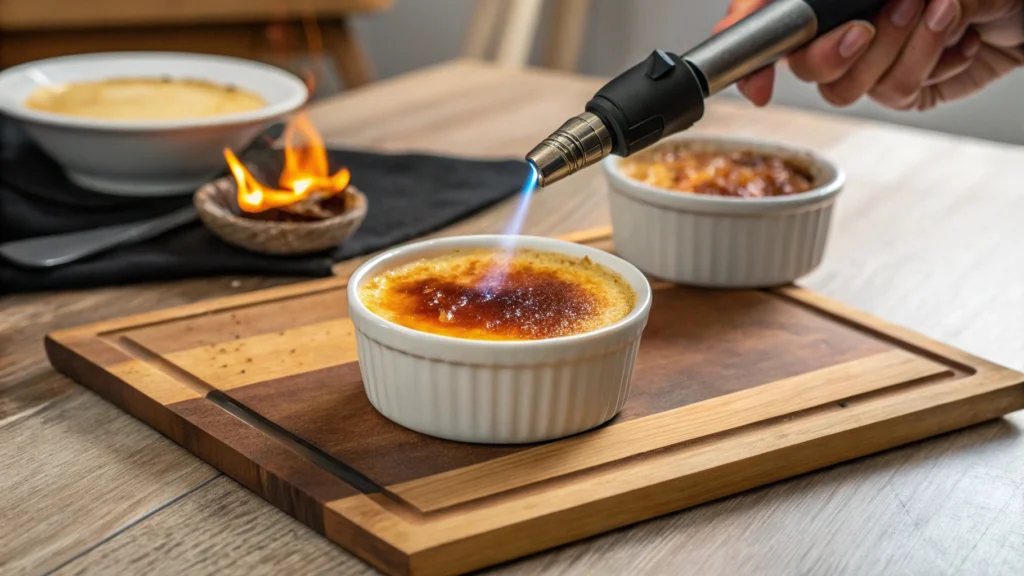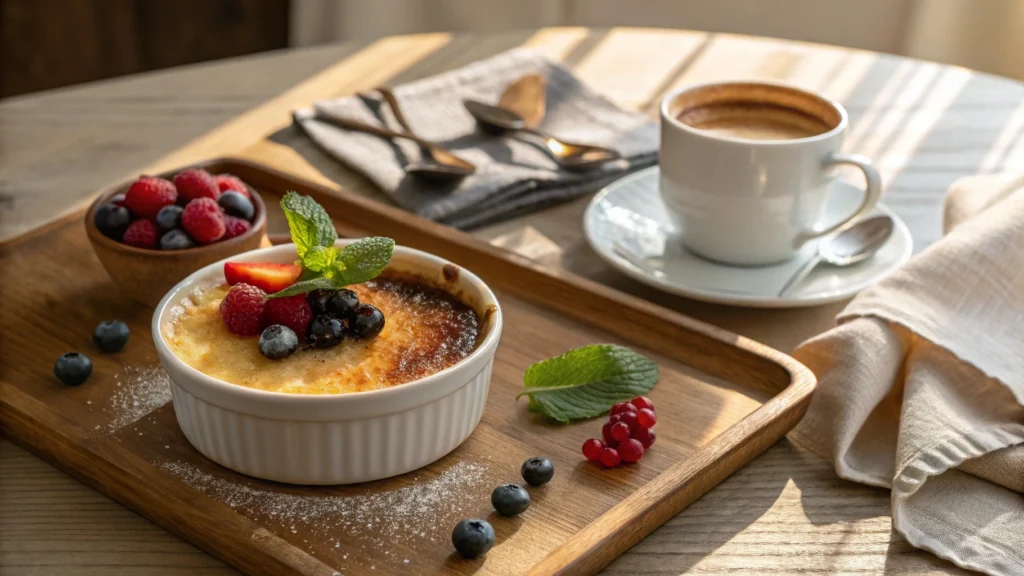Introduction
Crème brûlée is a timeless French dessert that combines a luscious custard base with a perfectly caramelized sugar topping. Traditionally made with heavy cream, this version of the recipe uses milk, resulting in a lighter but equally creamy dessert. If you’ve ever hesitated to try making crème brûlée at home, this guide will show you just how simple and rewarding it can be. With readily available ingredients and straightforward steps, this is truly the best crème brûlée recipe with milk you’ll find.
By swapping cream for milk, we’ve created an approachable dessert that doesn’t compromise on flavor or texture. Whether you’re a novice in the kitchen or a seasoned baker, this recipe will help you master the art of homemade crème brûlée. Imagine cracking through the thin caramelized sugar crust to reveal the velvety custard beneath—it’s a sensory experience that’s hard to resist.
If you’re ready to explore the world of milk-based crème brûlée, let’s get started. For a savory spin, you can even explore this unique twist with a crab brûlée recipe for savory dessert enthusiasts.
Table of contents
What is Crème Brûlée?
Crème brûlée, or “burnt cream,” is one of the most famous French desserts. It is composed of two essential components: a creamy custard base flavored with vanilla and a caramelized sugar crust. The balance between the silky texture of the custard and the crisp crunch of the sugar topping is what makes this dessert so unique.
This vanilla crème brûlée recipe stands out because it uses milk instead of heavy cream, making it a lighter alternative to the traditional version. The custard is created with milk, egg yolks, and sugar, while the caramel topping is made by torching granulated sugar to perfection. While similar to desserts like flan or pots de crème, crème brûlée is distinguished by its caramelized top layer.
Crème brûlée originated in France and was first documented in 1693 by François Massialot, a French chef. Over the centuries, it has become a staple dessert in French restaurants worldwide. While it may seem like an indulgence reserved for fine dining, this simple crème brûlée recipe proves you can recreate it at home with ease.
For a creative pairing, you can learn how to make cream-enriched French madeleines to pair with your classic crème brûlée. Together, they make a delightful dessert combination.
Why Use Milk Instead of Heavy Cream?
Many people wonder whether it’s possible to make crème brûlée with milk instead of heavy cream. The answer is a resounding yes. Using milk provides several benefits:
- Lighter Texture: Milk creates a custard that’s still rich and creamy but not as heavy as one made with cream. This is ideal for those who prefer lighter desserts.
- Healthier Option: Milk contains less fat than heavy cream, making this recipe a slightly healthier alternative without sacrificing flavor.
- Budget-Friendly: Milk is more affordable and often already available in most households, which adds to the accessibility of this recipe.
So, if you’ve been searching for the best crème brûlée recipe without heavy cream, this is the perfect solution. To make the custard even more indulgent, you could also try using evaporated milk, which has a thicker consistency.
If you’re intrigued by the idea of using milk, you may also enjoy this homemade vanilla paste recipe to enhance your crème brûlée.
Ingredients and Equipment
Making the best crème brûlée recipe with milk starts with assembling the right ingredients and tools. Here’s what you’ll need:
Ingredients:
- 2 cups whole milk: This is the base for the custard. For a slightly richer taste, you can substitute with evaporated milk.
- 4 large egg yolks: These provide structure and creaminess to the custard.
- ½ cup granulated sugar: Divided into two parts—one for the custard and one for the caramelized topping.
- 1 vanilla bean or 1 teaspoon vanilla extract: For a classic vanilla flavor. You can also experiment with vanilla paste for a more intense aroma.
- Pinch of salt: Enhances the overall flavor.

Equipment:
- Ramekins (4-6 ounces each): For individual servings.
- Baking dish: To set up the water bath, which ensures even cooking.
- Fine mesh strainer: To remove any lumps from the custard mixture.
- Blowtorch or broiler: For caramelizing the sugar topping.
For a nutty twist, consider pairing your crème brûlée with this moist pistachio bread recipe.
Step-by-Step Guide to Making Crème Brûlée with Milk
Creating the best crème brûlée recipe with milk is a simple process when broken down into manageable steps. By following these instructions, you’ll achieve a creamy custard base and a perfectly crisp caramelized sugar topping.
1. Preparing the Custard
- Heat the Milk: In a saucepan, warm 2 cups of whole milk over medium heat, adding a split vanilla bean or 1 teaspoon of vanilla extract. Heat until bubbles form around the edges but avoid boiling. Let it sit for 5 minutes to infuse.
- Mix Egg Yolks and Sugar: In a bowl, whisk 4 large egg yolks, ¼ cup sugar, and a pinch of salt until pale and creamy. This ensures a smooth custard.
- Combine Milk and Egg Mixture: Gradually pour the warm milk into the egg mixture while whisking continuously to prevent curdling.
- Strain the Custard: Pour the mixture through a fine-mesh sieve into a clean bowl to remove any lumps for a silky texture.
2. Baking in a Water Bath
- Divide the custard evenly among the ramekins.
- Place the ramekins in a deep baking dish. Carefully pour hot water into the dish until it reaches halfway up the sides of the ramekins.
- Bake in the preheated oven for 30-40 minutes or until the custards are set but still jiggly in the center.
- Remove the ramekins from the water bath and let them cool to room temperature before refrigerating them for at least 4 hours.
3. Caramelizing the Sugar Topping
- Sprinkle Sugar Evenly: Just before serving, sprinkle 1–2 teaspoons of granulated sugar evenly over the surface of each custard. Use the back of a spoon or a small sieve to spread the sugar in an even, thin layer.
- Torch the Sugar: Using a kitchen blowtorch, slowly melt the sugar by moving the flame in a circular motion. The sugar will bubble, then caramelize into a golden-brown crust. Be careful not to linger too long in one spot to avoid burning the sugar.
- Alternative Broiler Method: If you don’t have a blowtorch, place the ramekins on a baking sheet and broil them in the oven for 1–2 minutes. Watch closely to ensure the sugar caramelizes evenly without burning.
- Cool the Caramelized Top: Allow the caramelized topping to cool for 1–2 minutes before serving. This gives the sugar time to harden into a crispy crust.

4. Serving the Crème Brûlée
Once the sugar has hardened, the dessert is ready to serve. You can garnish it with fresh berries, a sprig of mint, or a dusting of powdered sugar for a decorative touch. The final step is the most satisfying: use a spoon to crack through the crisp caramel layer and enjoy the creamy custard underneath.
Pro Tip: Pair your crème brûlée with red velvet Oreo cookies for a decadent dessert spread or with cream-enriched French madeleines for a classic pairing.
By following these detailed instructions, you’ll achieve a flawless homemade crème brûlée that rivals any restaurant’s version.
Tips for Success-Best Crème Brûlée Recipe with Milk-
- Avoid Overbaking: The custard is ready when it wobbles slightly in the center. Overbaking can result in a rubbery texture.
- Smooth Custard: Strain the mixture to ensure a silky finish.
- Chill Thoroughly: Refrigerate the custards for at least 4 hours to allow them to set properly.
- Caramelizing Sugar Without a Blowtorch: Heat a metal spoon on the stove and press it against the sugar for an alternative caramelizing method.
Variations of Crème Brûlée
Once you’ve mastered the basic milk-based crème brûlée recipe, consider experimenting with these variations:
- Flavored Infusions: Add lavender, coffee, or citrus zest to the milk during heating for a unique flavor.
- Fruity Layers: Spread a thin layer of homemade apricot jelly at the bottom of the ramekins before pouring in the custard.
- Alternative Sugars: Use raw sugar for a textured caramel topping or brown sugar for a molasses-like flavor.
FAQs
Can I use milk instead of cream for crème brûlée?
Yes, you can absolutely use milk instead of cream to make crème brûlée. Using whole milk results in a lighter dessert while still maintaining the signature creamy texture. The custard will be slightly less rich than the traditional cream-based version but equally delicious. For those looking for an even creamier result without using heavy cream, evaporated milk is an excellent alternative. This option is perfect for those who want to enjoy a luxurious dessert without the extra calories or fat content of heavy cream.
What is a substitute for heavy cream in crème brûlée?
Whole milk is the most common substitute for heavy cream in crème brûlée. It provides a smooth and creamy texture while making the recipe lighter. Evaporated milk is another fantastic alternative because of its thicker consistency, which closely mimics cream. If you’re looking for a non-dairy option, full-fat coconut milk can also work, although it will add a coconut flavor to the custard. Whatever substitute you choose, the key is to maintain a good balance of fat and liquid to achieve the perfect custard texture.
What is the secret of crème brûlée?
The secret of a perfect crème brûlée lies in the balance of textures and flavors. The custard should be silky smooth and lightly flavored with vanilla, while the caramelized sugar topping should be thin and crispy. Using a water bath (bain-marie) is essential for evenly cooking the custard without curdling. Proper temperature control and careful caramelization are also crucial. Finally, chilling the custards thoroughly before serving allows the flavors to develop and the texture to set beautifully.
What’s the difference between crème brûlée and custard?
Crème brûlée is a specific type of custard, distinguished by its caramelized sugar topping. While custard is a general term for desserts made with a mixture of milk, eggs, and sugar, crème brûlée adds a unique twist with its thin, crackable layer of caramelized sugar. Traditional custards, like flan or pots de crème, are often served plain or with a sauce, but they lack the signature crunchy topping that makes crème brûlée so iconic. Additionally, crème brûlée is typically served in individual ramekins, adding to its elegant presentation.
Serving Suggestions
Pair your homemade crème brûlée with complementary desserts for a complete experience:
- Enjoy Chobani Banana Bread alongside crème brûlée for a decadent spread.
- Drizzle your crème brûlée with chocolate sauce or garnish with fresh berries for added flavor.

Conclusion
Making the best crème brûlée recipe with milk is not just about creating a delicious dessert; it’s about mastering a classic French recipe in a way that’s approachable and fun. This milk-based version allows you to enjoy all the indulgent creaminess of traditional crème brûlée while offering a lighter alternative that’s perfect for any occasion. Whether you’re hosting a dinner party or treating yourself to something special, this recipe is a guaranteed crowd-pleaser.
By following the step-by-step instructions, you’ll learn essential techniques like tempering eggs, using a water bath, and achieving the perfect caramelized sugar topping. These skills will not only help you make this dessert flawlessly but also enhance your confidence in the kitchen. Plus, the versatility of crème brûlée means you can get creative by infusing it with different flavors or pairing it with other desserts like red velvet Oreo cookies or pistachio bread.
Remember, the joy of crème brûlée lies in its simplicity—the creamy custard base paired with the satisfying crack of the caramelized sugar topping. It’s a dessert that feels luxurious yet is surprisingly easy to make at home. Don’t hesitate to experiment with variations or adapt the recipe to suit your taste preferences.
We hope this guide inspires you to try your hand at making this iconic dessert. Share your results, ask questions, and join the Delices Recipes community as we continue to make cooking accessible, fun, and rewarding. Bon appétit!
